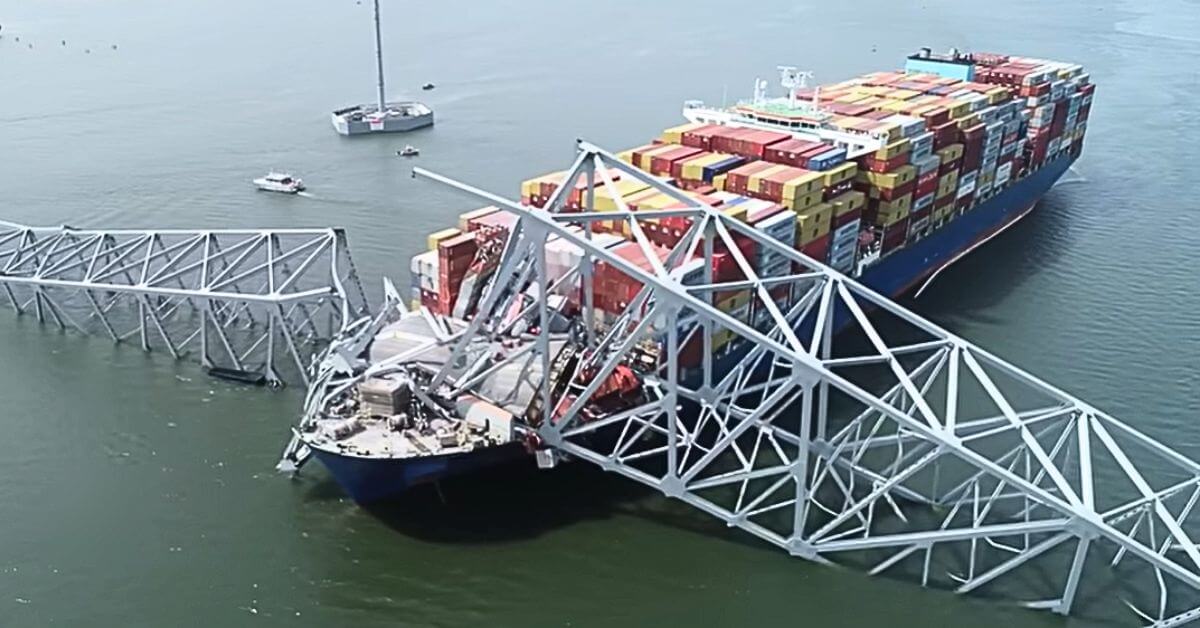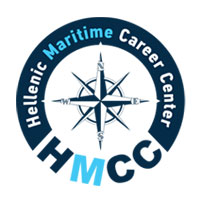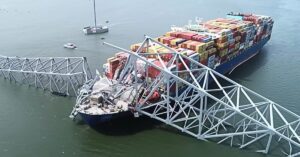Single Loose Wire On Containership Dali Caused Blackouts That Led To Collision With Baltimore’s Key Bridge

NGO Calls On EU To Use Ship Recycling to Cut Steel And Construction Emissions
November 18, 2025
Footage Captures Dramatic Moment Torpedo Struck Frigate & Sank It Within Minutes
November 19, 2025

A loose wire on the 984-foot containership Dali caused electrical blackouts that led the ship to hit Baltimore’s Francis Scott Key Bridge, collapsing part of the structure and killing six highway workers, the National Transportation Safety Board (NTSB) said on Tuesday.
During a public meeting, investigators explained that the wire had not been fully inserted into a terminal block because of wire-label banding. This caused a breaker to open unexpectedly, triggering two blackouts on the vessel. As a result, the Dali lost propulsion and steering while approaching the 2.37-mile-long bridge on 26 March 2024.
After the first blackout, the ship’s heading swung towards starboard, bringing it dangerously close to Pier 17 of the Key Bridge. The NTSB said that although the vessel’s pilots and the bridge team attempted to alter the ship’s trajectory, their efforts were ineffective due to the loss of propulsion and proximity to the bridge.
A large section of the bridge, including pier, deck, and truss spans, collapsed onto the bow of the ship and its forward container bays.
Video Credits: First Coast News/YouTube
Seven road maintenance workers and one inspector were on the bridge at the time. Six of the highway workers died in the accident. The NTSB stated that prompt actions by the Dali’s pilots, shoreside dispatchers and the Maryland Transportation Authority to stop traffic on the bridge prevented even more loss of life.
NTSB Chairwoman Jennifer Homendy said the investigation was extremely difficult because the Dali is nearly 1,000 feet long with miles of electrical wiring.
She explained that finding the loose wire was similar to looking for a loose rivet on a structure the size of the Eiffel Tower. She also said the accident was preventable and that following the NTSB’s recommendations would help avoid similar incidents in the future.
Investigators also highlighted the bridge’s vulnerability to collisions with large vessels. The Dali, at nearly 1,000 feet, is ten times the size of the Japan-flagged Blue Nagoya, which caused only minor damage to the Key Bridge after losing propulsion in 1980.
Video Credits: NTSBgov/YouTube
Earlier in the year, the NTSB released a report warning that many bridge owners across the United States, including the Maryland Transportation Authority, were likely unaware of how much risk large ocean-going vessels pose to their bridges.
This was despite long-standing guidance from the American Association of State Highway and Transportation Officials advising owners to assess such risks.
The NTSB sent letters to 30 bridge owners identified in the report, urging them to evaluate their structures and take action if needed. All of them have responded, and updates are available on the NTSB website.
As part of its response to the Dali accident, the NTSB issued new safety recommendations to the US Coast Guard, US Federal Highway Administration, American Association of State Highway and Transportation Officials, ClassNK, HD Hyundai Heavy Industries, Synergy Marine Pte. Ltd, WAGO Corporation, and multiple bridge owners across the United States.
A complete investigation report, including detailed findings, probable cause, and recommendations, is expected to be released in the coming weeks.
Reference: NTSB
Source: Maritime Shipping News


